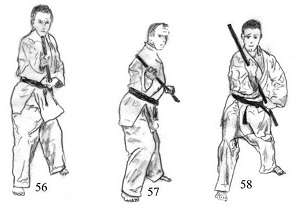Name
Shiramachi nu Kun is pronounced Shiromatsu no Kon in standard Japanese. Nagamine Shōshin is said to have referred to it as Hakushō no Kon, but Shiromatsu no Kun is the standard pronunciation used today. Regardless of the pronunciation it means “The White Pine cudgle form.”
Lineage(s)
It is said to be unknown who developed Shiromatsu no Kon, but it came to be handed down within the Matsubayashi-ryū lineage. It was taught at the Kōdōkan Honbu Dōjō of Nagamine Shōshin in Naha Kumoji. According to oral history, it was taught by Kyan Shin‘ei.
There’s another possibility: In 1955, Koja Shōshin was an assistant teacher at the Matsubayashi-ryū Kōdōkan of Nagamine Shōshin. In an interview he was asked where his bōjutsu came from, so it seems that he taught bōjutsu there. This might be another option for the origin of this kata. His answer to the question was:
“My teacher is venerable old man Sueyoshi Kōfū, the head (family) of bōjutsu, who is known as Shīshi no Tanmē.”
So the origin of Shiromatsu no Kon might as well be found in the lineage Sueyoshi Kōfū (Shīshi no Tanmē) → Koja Shōshin.
The Kata was taught in the US at least since the early 1970s by Heshiki Zenkō, who became a Zen priest living on Hawaii, who in turn learned it in the US by Ueshiro Ansei. Both Heshiki and Ueshiro have been students of Nagamine Shōshin and both Heshiki Zenkō and Ansei Ueshiro performed it a little differently. According to oral history, at that time they simply referred to it as “Bō-kata”, which was also the case in the Matsubayashi-ryū Honbu dōjō still in the 1985s. The kata was also handed down through Kishaba Chōkei, another former student at the Nagamine dōjō.
Versions
There are various versions of this kata, however they basically boil down to two:
- The old source version (see old film).
- The newer yamannized version, in which conceptions of Yamanni-ryū were employed to upgrade the kata.
In order to distinguish these two versions, they are sometimes referred to as Shiromatsu no Kon Ichi (original) and Shiromatsu no Kon Ni (yamannized version). In addition, one variety of the yamannized version is taught under the name of Rūybi no Kon.
Technical features
1. The old source version.

Uchi-maki-uke of old Shiromatsu no Kon.
As a characteristic technical combo it features a specific Uchi-maki-uke using both hands and the assistance of the hip. It is like “stirring in the pot.” In addition the hand-change is performed stationary and without rotating the bō. The tsuki (thrusts) are executed by first pulling back the bō, front tip slightly pointing upwards. With the thrust the bō is twirled and points slightly downwards.
The Furi-age-uchi (upward swing) is done on the shoulder while remaining in Zenkutsu-dachi.
Another characteristic feature is the finishing combo: Sukui-uke (scooping block), Gyaku-uchi-komi (reverse strike), Jōdan-age-uchi (upper level rising strike), Shōmen-uchi (upper level strike), Gedan-barai (low sweep) in a one leg stance, Shōmen-uchi, Uchi-uke.
See here two of the techniques of the old version that were skipped in the new one.
2. The newer yamannized version
Although there are verious version even among the yamannized version, it boils down to the following most notable upgrades.
The characteristic Uchi-maki-uke is skipped, and the hand-change is performed by rotating the bō.
The Furi-age-uchi (upward swing) is done into the armpit and while raising the body in Shizen-dachi (natural stance).
The Sukui-uke is performed in midair while jumping from right forward to right backward stance, followed by a new technique. This version also borrowed from Sakugawa no Kon.
See here a version performed by Higa Nobuhide, Hanshi 9th Dan of Taira dōjō (from Matsubayashi-ryu New Zealand website).
Note
The old version of Shiromatsu no Kon is quite stiff, no matter how much time you spent with it or how much power you place into it. When comparing to the updated version(s) of Shiromatsu no Kon this gets even more obvious. By adding new accomplishments any bōjutsu can be updated: in sense of continuous improvement (kaizen, a term from Japanese industrial engineering) this is desirable. Yet, there are some techniques that were skipped from the old version. I feel especially the Uchi-maki-uke is a very good technique. The hand change is also a variant that should be conserved. Parts of the finishing combo were changed very much, especially as the Age-uchi is skipped. In the end it’s about the questions if there a tactical functions in such combos. These should be studied, too, as these tactical functions have nothing to do with a good or bad exterior performance.
© 2015 – 2020, Andreas Quast. All rights reserved.
